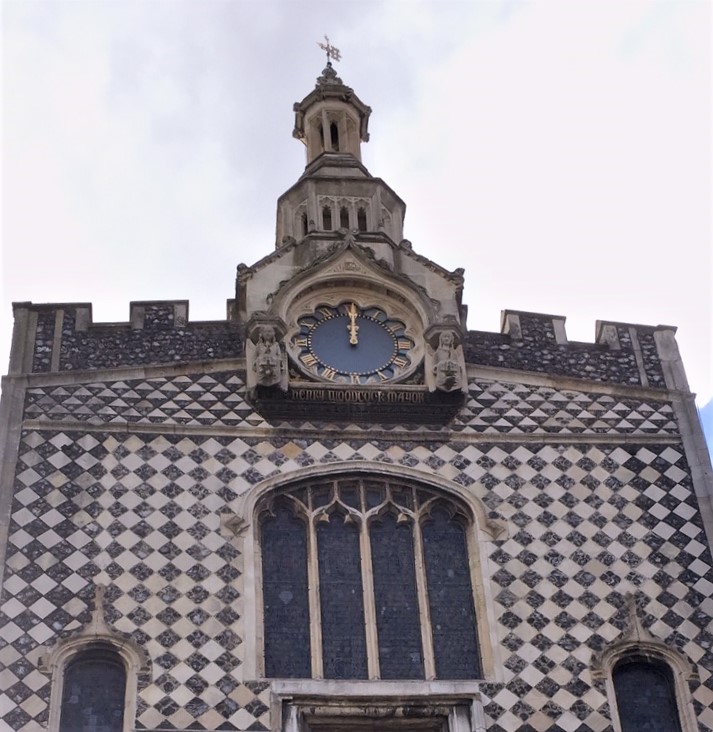Knapping

|
| Knapped stonework was often used for important buildings constructed during Norman and Saxon periods. One example is the Norwich Guildhall, built in the 1400s. The east end (pictured above) illustrates an example of smooth, chequerboard (or diaper) flushwork of knapped flint and light limestone. The stones are square-knapped to such a degree that galetting was not required - neither was mortar. |
Knapping is a technique used to shape flint (or other stone with similar characteristics). The purpose of knapping is to split the stone and make it into flat squares or other distinct shapes for decorative purposes.
The residual flakes of stone that are created as a result of knapping are sometimes saved and used to fill spaces and protect any exposed mortar. This technique is known as galetting.
In the case of knapped flint, the technique highlights the smooth black surface of flint, which can be framed in limestone. This treatment is called flushwork - the decorative use of knapped flint in conjunction with dressed stone to form patterns.
See also: Building with Flint: a practical guide to the use of flint in design and architecture.
[edit] Related articles on Designing Buildings
Featured articles and news
One of the most impressive Victorian architects. Book review.
RTPI leader to become new CIOB Chief Executive Officer
Dr Victoria Hills MRTPI, FICE to take over after Caroline Gumble’s departure.
Social and affordable housing, a long term plan for delivery
The “Delivering a Decade of Renewal for Social and Affordable Housing” strategy sets out future path.
A change to adoptive architecture
Effects of global weather warming on architectural detailing, material choice and human interaction.
The proposed publicly owned and backed subsidiary of Homes England, to facilitate new homes.
How big is the problem and what can we do to mitigate the effects?
Overheating guidance and tools for building designers
A number of cool guides to help with the heat.
The UK's Modern Industrial Strategy: A 10 year plan
Previous consultation criticism, current key elements and general support with some persisting reservations.
Building Safety Regulator reforms
New roles, new staff and a new fast track service pave the way for a single construction regulator.
Architectural Technologist CPDs and Communications
CIAT CPD… and how you can do it!
Cooling centres and cool spaces
Managing extreme heat in cities by directing the public to places for heat stress relief and water sources.
Winter gardens: A brief history and warm variations
Extending the season with glass in different forms and terms.
Restoring Great Yarmouth's Winter Gardens
Transforming one of the least sustainable constructions imaginable.
Construction Skills Mission Board launch sector drive
Newly formed government and industry collaboration set strategy for recruiting an additional 100,000 construction workers a year.
New Architects Code comes into effect in September 2025
ARB Architects Code of Conduct and Practice available with ongoing consultation regarding guidance.
Welsh Skills Body (Medr) launches ambitious plan
The new skills body brings together funding and regulation of tertiary education and research for the devolved nation.
Paul Gandy FCIOB announced as next CIOB President
Former Tilbury Douglas CEO takes helm.






















